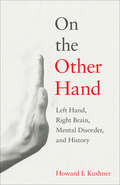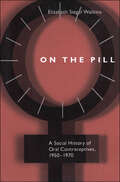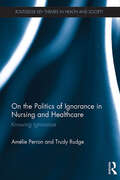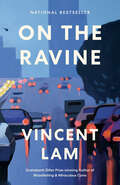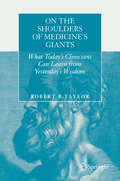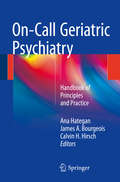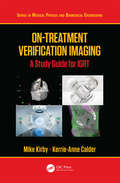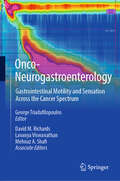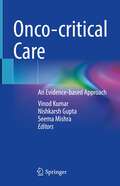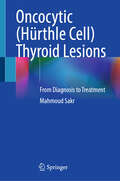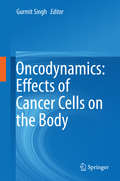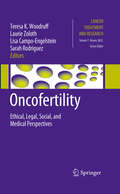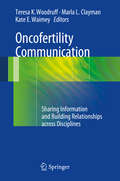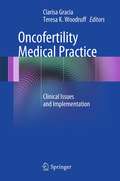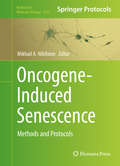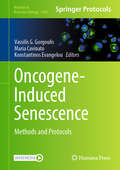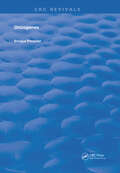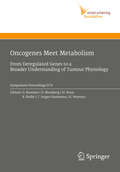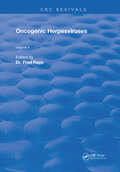- Table View
- List View
On the Other Hand: Left Hand, Right Brain, Mental Disorder, and History
by Howard I. KushnerDoes being left-handed make a person different in any way that matters?Since the late Stone Age, approximately 10 percent of humans have been left-handed, yet for most of human history left-handedness has been stigmatized. In On the Other Hand, Howard I. Kushner traces the impact of left-handedness on human cognition, behavior, culture, and health. A left-hander himself, Kushner has long been interested in the meanings associated with left-handedness, and ultimately with whether hand preference can even be defined in a significant way. As he explores the medical and cultural history of left-handedness, Kushner describes the associated taboos, rituals, and stigma from around the globe. The words "left" and "left hand" have negative connotations in all languages, and left-handers have even historically been viewed as disabled.In this comprehensive history of left-handedness, Kushner asks why left-handedness exists. He examines the relationship—if any—between handedness, linguistics, and learning disabilities, reveals how toleration of left-handedness serves as a barometer of wider cultural toleration and permissiveness, and wonders why the reported number of left-handers is significantly lower in Asia and Africa than in the West. Written in a lively style that mixes personal biography with scholarly research, On the Other Hand tells a comprehensive story about the science, traditions, and prejudices surrounding left-handedness.
On the Pill: A Social History of Oral Contraceptives, 1950-1970
by Elizabeth Siegel Watkins"In 1968, a popular writer ranked the pill's importance with the discovery of fire and the developments of tool-making, hunting, agriculture, urbanism, scientific medicine, and nuclear energy. Twenty-five years later, the leading British weekly, the Economist, listed the pill as one of the seven wonders of the modern world. The image of the oral contraceptive as revolutionary persists in popular culture, yet the nature of the changes it supposedly brought about has not been fully investigated. After more than thirty-five years on the market, the role of the pill is due for a thorough examination."—from the IntroductionIn this fresh look at the pill's cultural and medical history, Elizabeth Siegel Watkins re-examines the scientific and ideological forces that led to its development, the part women played in debates over its application, and the role of the media, medical profession, and pharmaceutical industry in deciding issues of its safety and meaning. Her study helps us not only to understand the contraceptive revolution as such but also to appreciate the misinterpretations that surround it.
On the Politics of Ignorance in Nursing and Health Care: Knowing Ignorance (Routledge Key Themes in Health and Society)
by Amelie Perron Trudy RudgeIgnorance is mostly framed as a void, a gap to be filled with appropriate knowledge. In nursing and health care, concerns about ignorance fuel searches for knowledge expected to bring certainty to care provision, preventing risk, accidents, or mistakes. This unique volume turns the focus on ignorance as something productive in itself and works to understand how ignorance and its operations shape what we do and do not know. Focusing explicitly on nursing practice and its organization within contemporary health settings, Perron and Rudge draw on contemporary interdisciplinary debates to discuss social processes informed by ignorance, ignorance’s temporal and spatial boundaries, and how ignorance defines what can be known by specific groups with differential access to power and social status. Using feminist, postcolonial and historical analyses, this book challenges dominant conceptualizations and discusses a range of "nonknowledges" in nursing and health work, including uncertainty, abjection, denial, deceit and taboo. It also explores the way dominant research and managerial practices perpetuate ignorance in healthcare organisations. In health contexts, productive forms of ignorance can help to future-proof understandings about the management of healthy/sick bodies and those caring for them. Linking these considerations to nurses’ approaches to challenges in practice, this book helps to unpack the power situated in the use of ignorance and pays special attention to what is safe or unsafe to know, from both individual and organisational perspectives. On the Politics of Ignorance in Nursing and Health Care is an innovative read for all students and researchers in nursing and the health sciences interested in understanding more about transactions between epistemologies, knowledge building practices and research in the health domain. It will also be of interest to scholars involved in the interdisciplinary study of ignorance.
On the Ravine: A Novel
by Vincent LamFrom the bestselling, Giller Prize-winning author of Bloodletting & Miraculous Cures comes an exquisitely crafted novel, piercing in its urgency and breathtaking in its intimacy, about the devastating experience of addiction.In his downtown Toronto condo, Dr. Chen awakens to the sound of streetcars below, but it is not the early morning traffic that keeps him from sleep. News banners run across his phone: Fentanyl Crisis; Toxic Drug Supply; Record Number of Deaths. From behind the headlines, on the same screen, glow the faces of his patients, the faces of the what-ifs: What if he had done more, or less? Or something different? Would they still be alive?Claire is a violinist; she feels at one with her music, taking flight in its melody, free in its movement. But now she rises and falls with the opioids in her system, becoming increasingly reckless. After two overdoses in twenty-four hours, she sits in the blue light of her computer, searching a notice board for recommendations: my doctor saved my life; my doctor is just another dealer. And then another message catches her attention, about Chen&’s clinic: be a guinea pig—why not get paid to take it?When Claire&’s life intersects with Chen&’s, the doctor is drawn ever more deeply into the complexities of the doctor-patient relationship, the implication and meaning of his intention to treat. Chen must confront just how far he would go to save a life. Combining the depth of his experience as a physician with the brilliance of his literary talent, Vincent Lam creates a world electric in its precision, radiant in its detail. On the Ravine is a gripping novel of profound emotional force, a soaring achievement from a singular voice in Canadian fiction.
On the Self: Discourses of Mental Health and Education (The Language of Mental Health)
by Julie Allan Valerie HarwoodThis book examines the emergence of psychologised discourses of the self in education and considers their effects on children and young people, on relationships both in and out of school and on educational practices. It undertakes a Foucauldian genealogy of the discourses of the self in education in order to scrutinise the ‘focal points of experience’ for children and young people. Part One of the book offers a critical analysis of the discourses of the self that operate within interventions of self esteem, self concept, self efficacy and self regulation and their incursions into education. Part Two provides counter-narratives of the self, drawn principally from the arts and politics and providing alternative, and potentially radical, ways of when and how the self might speak. It also articulates how teachers may support children and young people in giving voice to these counter-narratives as they move through school.
On the Shoulders of Medicine's Giants
by Robert B. TaylorMedical history offers us many wise thoughts, a few misguided notions, and a host of intriguing back-stories. On the Shoulders of Medicine's Giants presents a selection of these, and tells how the words of medicine's "giants"--such as Hippocrates, Sir William Osler, Francis Weld Peabody, and Elizabeth Kübler-Ross--are relevant to medical science and practice in the 21st century. Which physician was the inspiration for the fictional character Sherlock Holmes, and what did he identify as "the real essential factor in all successful medical diagnosis"? What did Sigmund Freud describe as his "tyrant," and what might this mean for doctors today? Do you know the attributed source of the well-known aphorism about horses and zebras, and what we believe this physician actually said? This book answers these questions and more, while also providing fascinating tales about each individual quoted. On the Shoulders of Medicine's Giants is recommended for practicing physicians, students, and residents, as well as nurse practitioners, physician assistants, and anyone involved in patient care who wants to understand the historical and epistemological foundations of what we do each day in practice.
On the Sweet Spot
by Richard KeefeLike most moments of spiritual revelation, this one took place on a landfill in New Jersey. A young man is standing at an unprepossessing driving range, hitting balls toward a distant fence, when something unusual takes place. As he begins his swing, he has the sensation that his club is drawing itself back on its own; when it is ready, it starts downward, makes perfect contact, and the ball soars off in the right-to-left arc he'd imagined, hitting the exact fencepost he'd been aiming at from 250 yards away. He steps back and wonders if he can do it again. He feels like an observer as the swing begins itself and resolves itself after perfect contact with the waiting ball, which again smacks against the distant post. He has, for however brief a time, entered "the zone. "Everyone who plays a sport knows that fleeting, ineffable sensation of everything falling into place: The pitched baseball looks as big as a grapefruit, the basket looks as wide as a trash can, the players around you are moving in slow motion. But as Richard Keefe, the director of the sport psychology program at Duke University, looked deeper into the nature of his experience, he found profound links to the spirit, the brain, perhaps even the soul. Keefe recognized that the feeling golfers and other athletes have of "being in the zone" is basically the same as a meditative state. And as a researcher with experience in brain chemistry, he went one step further: If we can figure out what's happening in the brain at such times, he reasons, we can learn how to get into that "zone" instead of just waiting for it to happen. This is the Holy Grail of sport psychology -- teaching the mind to get out of the way so the body can do the things it's capable of doing. Keefe calls it the "effortless present," when the body is acting of its own accord while the brain has little to do but watch. All religions describe some kind of heightened awareness in their disciplines; Keefe explores whether such mystical experience is a fundamental aspect of our evolution, an integral part of what makes us human and keeps us from despair. And he brings the discussion back to the applications of such knowledge, reflecting on our ability to use these alternate planes to achieve better relationships, better lives, better moments. Keefe's true subject is extraordinary experience -- being in the zone, in the realm of effortless action. On the Sweet Spotbuilds from the physical and neurological to the mystical and philosophical, then adds a crucial layer of the practical (how we can capture or recapture these wondrous states). It is a work in the proud tradition ofThe Sweet Spot in Time, Flow: The Psychology of Optimal Experience, and How the Mind Works.
On-Call Geriatric Psychiatry
by James A. Bourgeois Ana Hategan Calvin H. HirschThis text covers basic principles and practice of on-call psychiatric care in the geriatric patient in various medical settings. It compiles the most likely complaints and provides assessment and management tools for each situation. Written and edited by expert geriatric psychiatrists, emergency psychiatrists, consultation/liaison psychiatrists, geriatricians, and other multidisciplinary specialists, this is the first handbook devoted to on-call geriatric psychiatry. Chapters contain an important summary of key points for managing clinical situations, case studies, and reflective questions. This text brings together relevant principles of on-call geriatric psychiatry provided in clinical settings such as emergency, acute and subacute inpatient, outpatient, residential, correctional, and consultation/liaison. It includes clinical topics such as psychopharmacology, psychotherapy, substance abuse, and includes coverage of medical ethics and the law, utilization of contemporary technology, and administrative and public health policy. On-Call Geriatric Psychiatry is the first practical guide to knit together evidence-based medicine and geriatric psychiatric principles and practice guidelines and is a valuable resource for trainees, psychiatrists, geriatricians, emergency departments, nursing home physicians, and other health professionals working with older adult patients.
On-Treatment Verification Imaging: A Study Guide for IGRT (Series in Medical Physics and Biomedical Engineering)
by Mike Kirby Kerrie-Anne CalderOn-treatment verification imaging has developed rapidly in recent years and is now at the heart of image-guided radiation therapy (IGRT) and all aspects of radiotherapy planning and treatment delivery. This is the first book dedicated to just this important topic, which is written in an accessible manner for undergraduate and graduate therapeutic radiography (radiation therapist) students and trainee medical physicists and clinicians. The later sections of the book will also help established medical physicists, therapeutic radiographers, and radiation therapists familiarise themselves with developing and cutting-edge techniques in IGRT. Features: Clinically focused and internationally applicable; covering a wide range of topics related to on-treatment verification imaging for the study of IGRT Accompanied by a library of electronic teaching and assessment resources for further learning and understanding Authored by experts in the field with over 18 years’ experience of pioneering the original forms of on-treatment verification imaging in radiotherapy (electronic portal imaging) in clinical practice, as well as substantial experience of teaching the techniques to trainees
Onboarding in der Pflege: Ankommen – Wohlfühlen – Bleiben
by Andrea FischerIn der heutigen Zeit ist es wichtiger denn je, neue Mitarbeitende willkommen zu heißen und nachhaltig in das Team zu integrieren. Dieses Buch bietet Führungskräften im Pflegebereich praxisnahe Strategien und innovative Konzepte, um den Onboarding-Prozess erfolgreich zu gestalten. Eine strukturierte und wertschätzende Einarbeitung stärkt sowohl die neuen Mitarbeitenden, und fördert zudem die langfristige Bindung an das Team und trägt zu einem angenehmen Arbeitsklima bei. Nur wenn sich Pflegende selbst gut aufgehoben fühlen, können sie ihre Aufgabe mit Freude und Kompetenz erfüllen und bleiben der Einrichtung langfristig treu.
Once a Giant: A Story of Victory, Tragedy, and Life After Football
by Gary MyersThe inside story of the Super Bowl champion 1986 Giants, the extraordinary friendships that resulted--and stunning revelations about the hardships they faced, based on new interviews with Bill Parcells, Phil Simms, Mark Bavaro, and Bill Belichick. The 1986 New York Giants are legendary. A championship team coached by Bill Parcells and his wunderkind assistant Bill Belichick, featuring future Hall of Famers and All-Pros like Phil Simms, Lawrence Taylor, Mark Bavaro, and Harry Carson. They were dominant on the field and formed a unique and lasting bond off of it. More than thirty years later, it's the friendships that have proved more important--a matter of life and death. In Once a Giant, bestselling football writer Gary Myers tells the story of that team and what became of it. Gridiron glory eventually faded; chronic pain, addiction, and in some cases crimes have followed. Many football players face these harsh realities, but the Giants have confronted and survived them together. With unprecedented access, Myers dives into such issues as Mark Bavaro's battle with injuries, the breakup and reconciliation of Parcells and Belichick, and Lawrence Taylor's struggles with sobriety. He creates a never-before-seen portrait of the team's run to the title, and their even more challenging fight to live after it ended.
Once a Midwife: A Hope River Novel (Hope River Ser. #03)
by Patricia HarmanWelcome back to Hope River in USA Today bestselling author Patricia Harman’s newest novel as midwife Patience Hester, along with her family and friends, face the challenges of the home front during World War II.The women of Hope River trust midwife Patience Hester, whose skill in delivering babies is known for miles around. But though the Great Depression is behind them, troubles are not, for Europe is at war…and it can only be a matter of time before the U.S. enters the fray.And while some are eager to join the fight, Patience’s husband, Daniel, is not. Daniel is a patriot—but he saw too much bloodshed during the First World War, and has vowed never to take up arms again. His stance leaves Patience and their four children vulnerable—to the neighbors who might judge them, and to the government, who imprison Daniel for his beliefs.Patience must support their family and fight for her husband’s release despite her own misgivings. And with need greater than ever, she must also keep her practice running during this tumultuous time…relying on generous friends, like Bitsy, who has returned to Hope River, stalwart neighbors, and her own indomitable strength to see them all through.
Onco-Neurogastroenterology: Gastrointestinal Motility and Sensation Across the Cancer Spectrum
by George Triadafilopoulos David M. Richards Lavanya Viswanathan Mehnaz A. ShafiGastrointestinal sensory-motor dysfunction may cause acute, subacute, or chronic and variable digestive symptoms, and it may be overlooked as a factor across the cancer spectrum. The process may be regional or generalized, involving the entire gastrointestinal tract and it may be primary (a result of tumor-induced infiltrative denervation), or secondary to prior oncologic, surgical or radiation therapy. Sensory-motor dysfunction may precede, occur concurrently, or follow cancer, and it may be a manifestation of limited, metastatic, or even cured cancer. Clinical consideration and use of modern technology may help with diagnosis and therapy, thus improving quality of life in such patients. This book compiles and presents the most clinically important issues in Onco-Neurogastroenterology to help anyone taking care of patients with cancer-related gastrointestinal problems.
Onco-critical Care: An Evidence-based Approach
by Vinod Kumar Nishkarsh Gupta Seema MishraThis book provides insights into the care of cancer patients in the intensive care unit in a comprehensive manner. It provides an evidence-based approach to practitioners and postgraduate students to understand about the critical care needs of the patients suffering from malignancies. It helps the readers to develop critical thinking and encourage discussion towards improving the overall care of the patients and their families as their optimal management requires expertise in oncology, critical care, and palliative medicine and there is a dearth of books explaining about the special requirements and critical care needs of cancer patients.Each chapter is prepared by an expert in the field and contains well-prepared illustrations, flowcharts and relevant images. Chapters include latest evidence-based information which is useful for the readers.The book is useful for residents, fellows and trainees in the field of onco-anaesthesia, onco-critical care, onco-surgery, critical care and anaesthesia; practitioners and consultants in anaesthesia and onco-anaesthesia as well as intensivist, critical care experts and postgraduates in nursing.
Oncocytic (Hürthle Cell) Thyroid Lesions: From Diagnosis to Treatment
by Mahmoud SakrThis book provides a comprehensive overview of oncocytic (Hürthle cell) lesions, whether neoplastic or non-neoplastic, with a view to clarifying some uncertainties and helping clinicians reach an accurate diagnosis and choose the best therapeutic options.Many recent studies have highlighted important facts relevant to oncocytic (Hürthle cell) lesions and have proposed several clinical and non-clinical tools that may help in diagnosis and management. Recent molecular studies have shed light on the distinct oncogenic features of oncocytic/Hürthle cell carcinomas, suggesting that they represent a separate pathological entity from both oncocytic/Hürthle cell adenomas and follicular cell carcinomas. However, only a few facts are established, while challenges and debates still encompass most of the spectrum of oncocytic (Hürthle cell) lesions.The volume discusses a wide range of topics, including controversies in nomenclature, origin, and cytology/histology of oncocytic (Hürthle) cells, as well as controversies in oncocytic cell lesion pathogenesis, biological and clinical behavior, diagnosis, and management.Regarding oncocytic (Hürthle cell) neoplasms, this book discusses controversies in pathological classification, clinical presentation, diagnostic work-up, and therapeutic strategies. A special chapter addresses updates in genetic and molecular diagnostics of oncocytic (Hürthle cell) carcinoma.Finally, this book includes a chapter summarizing the recent international guidelines and recommendations related to oncocytic lesions, particularly carcinoma, thus aiding in decision-making and appropriate management.This book is meant for all specialists entrusted with the care of patients suffering from oncocytic thyroid lesions: head and neck surgeons, maxillofacial surgeons, endocrine surgeons, endocrinologists, oncologists, and otolaryngologists.
Oncodermatology: An Evidence-Based, Multidisciplinary Approach to Best Practices
by Cristina Martinez Zugaib Abdalla José Antonio Sanches Rodrigo Ramella Munhoz Francisco Aparecido BelfortThe purpose of this book is to outline the topics that are critical in the dermatological approach to patients with cancer. This purpose will be accomplished by discussing the value of a multidisciplinary approach, and case examples will be used, including some from the Hospital Sírio-Libanês, a pioneering institution in the treatment of cancer. In all, the book will present and discuss the best global evidence for the dermatologic care of patients with cancer, skin cancer, and solid organ- and bone-marrow-transplanted patients. The clinical, surgical, pathologic, imaging, radiotherapy, oncology and palliative care aspects of the dermatologic care of cancer patients will be covered. The book will also discuss subjects such as genetics, biology, evidence-based medicine, and new diagnostic methods and tools such as dermoscopy and confocal microscopy. Chapters will be based on the following key areas: educating clinicians on how to prevent skin cancer in patients, screening and counseling, diagnosis and treatment of pigmented lesions, melanoma and nonmelanoma skin cancer, cutaneous lymphomas, sarcomas, leukemic and lymphomatous infiltrations, cutaneous metastases, cutaneous paraneoplasic manifestations and cutaneous adverse reactions to chemotherapy and radiation treatment. The primary audiences are dermatologists, oncologists, radioncologists and oncologic surgeons. The secondary audience is residents in these fields. The goal is to prepare and update all specialists on this important clinical and research area.
Oncodynamics: Effects of Cancer Cells on the Body
by Gurmit SinghThis volume will introduce new terminology to the field of oncology, subdividing it into oncokinetics--the mechanics of the tumor cells as they arise and spread throughout the body--and oncodynamics--the impact of abnormal cues generated by tumors on the physiological functioning of the body. The volume will outline the importance of oncodynamics from both a cancer patient's and a caregiver's perspectives, stressing its significant impact on cancer patient functionality and the opportunity that cancer researchers will have to develop cross-disciplinary interactions and predict potential consequences of tumors and/or treatment.
Oncofertility
by Lisa Campo-Engelstein Sarah Rodriguez Laurie Zoloth Teresa K. WoodruffOncofertility has emerged as a way to address potential lost or impaired fertility in cancer patients and survivors, with active biomedical research that is developing new ways to help these individuals preserve their ability to have biological children. In order to move beyond oncofertility as a science and medical technology and begin to address the ethical, legal, and social ramifications of this emerging field, we must give voice to scholars from the humanities and social sciences to engage in a multidisciplinary discussion. This book brings together a pool of experts from a variety of fields, including communication, economics, ethics, history, law, religion, and sociology, to examine the complex issues raised by recent developments in oncofertility and to offer advice from national and international perspectives as we create new technology. Given the inherent interdisciplinary nature of oncofertility, this book is not only valuable, but also necessary to cultivate a deep understanding of new issues with the eventual aim of offering proposals for addressing them. Indeed, this book will be useful for people not only within the humanities and social sciences disciplines but also for those who are confronted with cancer and the possibility of impaired fertility and the medical practitioners within oncology and reproductive medicine who are at the front lines of this emerging field.
Oncofertility Communication
by Teresa K Woodruff Marla L Clayman Kate E WaimeyOncofertility integrates the two previously distinct fields of cancer treatment and fertility research and aims to explore and expand the reproductive future of cancer survivors. In order to achieve the goal of fertility preservation, the Oncofertility community must focus on communication and the way data is provided and received. Concomitant with the rapidly changing technology of Oncofertility, there have been radical shifts and advances in the way health educators and clinicians can produce and share information. As success rates of reproductive techniques such as egg freezing and banking continue to rise, providing increasing opportunities for young cancer patients to preserve their fertility prior to the onset of cancer treatments, communication among professionals in oncology, reproductive medicine, and psychosocial work, among others, becomes crucial, and clinical demand for Oncofertility information is expected to rise considerably. Oncofertility Communication describes and addresses the myriad channels through which the multiple audiences involved in Oncofertility can be served with appropriate and accurate information about cancer-related fertility issues. The text answers frequently asked questions and provides invaluable insights to scientific and health care professionals about communication among the diverse Oncofertility audiences. It incorporates timely discussions about traditional and emerging electronic communication tools and discusses the impact of health care policy changes on the Oncofertility field.
Oncofertility Medical Practice
by Teresa K Woodruff Clarisa GraciaOncofertility is a specialty that bridges the disciplines of reproductive endocrinology and infertility and oncology, with the goal of expanding the reproductive options of cancer patients. Given fertility risks associated with specific cancer treatments, as well as the improved long-term survival made possible by these therapies, there has been growing interest in expanding reproductive options for cancer patients. Indeed, both cancer survivors and the medical community have acknowledged the importance of patient counseling and the pursuit of fertility preservation options prior to starting cancer treatment. Oncofertility Medical Practice: Clinical Issues and Implementation is the third in a series of timely and indispensable books on fertility preservation for cancer patients--the first one focused on advances in basic science research and the second one offered ethical, legal, and social perspectives on the theme. This book elucidates the latest practices and emerging treatments in oncofertility and provides necessary information on the successes, risks, and limitations of fertility preserving technologies. Authoritative and insightful, written by an impressive multi-disciplinary cadre of specialists, this book is a valuable up-to-date resource for all those practicing in this demanding field. "This excellent text is an invaluable resource and a "must read" for clinicians and researchers interested in Oncofertility. The editors and authors need to be congratulated for their fine work." Roger A. Lobo, MD, Professor of Obstetrics and Gynecology, Columbia University and Past President of the American Society for Reproductive Medicine
Oncogene-Induced Senescence
by Mikhail A. NikiforovThis book offers in a single volume a unique collection of the state-of the-art experimental procedures utilized for the induction, detection, and modeling of this complex cellular program of oncogene-induced senescence. The book encompasses protocols for studying this multi-step program in human specimens and a variety of experimental models including cultured mammalian cells, laboratory mice, and Drosophila melanogaster, as well as offering a description of high throughput approaches. Written for the highly successful Methods in Molecular Biology series, chapters include introductions to their respective topics, lists of the necessary materials and reagents, step-by-step, readily reproducible laboratory protocols, and tips on troubleshooting and avoiding known pitfalls. Authoritative and practical, Oncogene-Induced Senescence: Methods and Protocols represents a valuable asset for a wide audience of medical oncologists and researchers in the fields of oncology, molecular and cellular biology, biochemistry, and animal development.
Oncogene-Induced Senescence: Methods and Protocols (Methods in Molecular Biology #2906)
by Vassilis G. Gorgoulis Maria Cavinato Konstantinos EvangelouThis volume explores a collection of the most recent experimental approaches for the detection, modelling, characterization, and in-depth computational analysis of the biological phenomenon known as Oncogene-Induced Senescence (OIS). The chapters in this book cover topics such as protocols to study OIS in two-dimensional, three-dimensional, and in vivo (animal and human) settings; analyzing OIS using high-throughput bioinformatics; and discriminate OIS from aging. Published in the highly successful Methods in Molecular Biology series format, chapters include introductions to their respective topics, lists of the necessary materials and reagents, step-by-step and readily reproducible laboratory protocols, and tips on troubleshooting to avoid known pitfalls.Comprehensive and authoritative, Oncogene-Induced Senescence: Methods and Protocols is a valuable resource for basic researchers and clinicians in the oncology field, and a great guide for computational scientists.
Oncogenes (Routledge Revivals)
by Enrique PimentelFirst published in 1986, this comprehensive work focuses on the "Acute and Chronic Transforming Retroviruses," "Cellular and Viral Oncogenes," "Functions of Oncogene and Protooncogene Protein Products," and "Oncogenes and Cancer." The number of oncogenes presently identified has grown to more than double of that which was discussed in the first edition of this book. It more clearly explains the relation of protooncogenes to neoplastic diseases, especially to human cancer. This updated edition is an absolute must for all physicians and biologists.
Oncogenes Meet Metabolism
by Guido Kroemer Dominik Mumberg Thomas Steger-Hartmann Björn Riefke Kirstin Petersen Kector KeunIn 1920s, Otto Warburg described the phenomenon of 'aerobic glycolysis', the ability of tumour cells to convert glucose to lactate in the presence of normal oxygen conditions. Warburg's hypothesis of an altered metabolism in cancer cells found no immediate acceptance, though it was latter confirmed for most human tumours. With the advent of molecular biology the focus in tumour research has shifted towards the search for oncogenes. However, the interest in cancer molecular profiling eventually led to a renaissance of the Warburg effect trying to combine genetic alterations with effects on metabolism with the help of modern analytic technologies to rapidly analyze broad varieties of metabolites in various tissues and bodyfluids (metabonomics).
Oncogenic Herpesviruses: Volume 2 (Routledge Revivals)
by Fred RappFirst published in 1980: This book attempts to coalesce current information regarding the oncogenic properties of those human and animal herpesviruses which has been studied in some detail.
